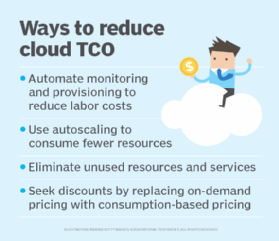Cloud TCO: How to calculate cloud total cost of ownership
Unsure what it will cost to run workloads in the cloud? Learn the variables you need to compare on-premises deployment to cloud deployment and avoid costly surprises later on.
Public cloud service providers are transparent about their pricing for cloud services, but that doesn't mean it's easy to determine what it will cost in total to operate in the cloud. The pricing is usually complex, which makes it difficult to estimate what your total expenses will be. There are many indirect costs to consider when calculating cloud total cost of ownership (TCO), such as licensing fees for software that businesses use to monitor and manage their cloud environments.
Nonetheless, calculating cloud TCO is critical if you want to be certain that the cloud delivers better value than on-premises infrastructure.
What is cloud TCO?
Cloud TCO is a metric that measures the total expense businesses incur for cloud workloads.
Cloud TCO is an aggregate of a variety of other data points, such as the cost of cloud services, data transfer fees imposed by cloud providers and the price of the monitoring tools used to support cloud workloads. Personnel costs, too, can be part of the cloud TCO equation.
Benefits of calculating cloud TCO
Accurately calculating cloud TCO provides several advantages that are important for maximizing the business value of the cloud, including the following:
- Making informed decisions about whether it makes more financial sense to run workloads on-premises or in the cloud.
- Quantifying the ROI of cloud investments so organizations know which cloud services or strategies yield the highest business value.
- Estimating future expenses associated with the cloud, which can help with cash flow management.
- Positioning organizations to optimize the cost of their cloud environments by determining whether changes, such as reconfiguring cloud services, reduce TCO.
Factors that influence cloud TCO
Part of the challenge of calculating cloud TCO is that many variables can affect the figure. Some are easier to measure than others.
For example, consider the following costs that are typically associated with running workloads in the cloud:
- The cost of CPU, memory and storage resources consumed by workloads in the cloud. Cloud providers publish transparent pricing for these costs, so they are usually easy to predict. However, in some cases, such as those involving workloads with widely varying resource consumption patterns, it can be challenging to know ahead of time what the costs will be because your resource consumption patterns aren't predictable.
- Data egress fees, which cloud providers typically charge when customers move data out of a cloud region or platform. Cloud providers are also transparent about these fees, but here again, you often don't know how much data you'll transfer -- and hence what your fees will be -- until after the fact.
- Purchase or subscription fees for software products that businesses use to back up, monitor, secure and manage cloud environments. Pricing models for this software, which can come from cloud service providers (CSPs) as built-in tools or from third-party vendors, vary widely; this makes costs challenging to predict and track in a standard way. In addition, you might use the same tools for managing on-premises workloads in addition to the cloud, so you can't always assume your tool budget is directly linked to cloud TCO.
- The personnel costs of migrating workloads to the cloud and managing them once they're there. This cost factor is also hard to measure. Often, you can't simply track it by staff compensation alone because IT might perform additional tasks alongside cloud migration and management. So, you need to determine how much time they spend working on the cloud and track that as a fraction of their total compensation.
There are also intangible costs to account for in a TCO model, such as risk management, flexibility and scalability, which can be difficult to quantify but are important in the big picture. Some of these, such as risk management and specific aspects of security, are partly absorbed by the CSP under the shared responsibility model. Others, such as flexibility and opportunity cost, reflect how certain costs can restrict or free up the ability to invest in other areas of the business.
How to calculate cloud TCO
Because every organization's cloud environment is unique, there is no simple set of steps that all businesses can follow to calculate cloud TCO. Nevertheless, the process usually boils down to the following.
1. Set a timeframe
The first step is to decide on a period of time during which you'll track cloud costs to calculate the TCO. It should be long enough to cover routine fluctuations in workload utilization that could affect cost, such as seasonal increases in application use.
You should also avoid tracking cloud TCO during periods of unusual spending, such as the first month or two following cloud migration. During that period, your team is still in the process of setting up and configuring cloud workloads, so expenses during this time do not accurately reflect ongoing operating costs.
2. Track cloud infrastructure costs
Next, measure the total CPU, memory, storage and data egress costs associated with operating cloud workloads over the period of time you've established for calculating TCO. If your workloads are already running in the cloud, you can use billing reports from your cloud provider to collect this data. If they're not yet in the cloud and you're trying to estimate cloud TCO to determine whether it makes sense to migrate, the cloud pricing calculators that cloud providers offer can help you predict the costs.
3. Measure indirect costs
After calculating direct costs, move on to the more complex task of assessing indirect costs associated with using the cloud, such as personnel costs and the cost of software tools and services.
As noted above, these costs tend to be more challenging to quantify because not all personnel and software tool costs are necessarily linked entirely to cloud spending. Nonetheless, it's possible to gain an accurate estimate of the portion of spending in these categories that is linked to the cloud.
For instance, if the average IT technician spends 60% of their time on work related to cloud management, and their total cost to the business (including salary, benefits and payroll taxes) is $150,000, then the total staffing costs that factor into cloud TCO are equal to $90,000 (the product of $150,000 and 0.6) multiplied by the total number of IT staff.
4. Factor in cloud migration costs
In addition to the cost of operating workloads once they're in the cloud, migrating them to the cloud in the first place comes with its own costs. These can vary depending on the method chosen, but they often include costs such as paying software developers to refactor applications as part of the migration, buying software tools to assist in cloud migration and working with third-party service providers to help plan and execute the migration.
Although most of these are one-time costs, you should factor them into cloud TCO because you can't use the cloud if you don't migrate to it in the first place. The exception is businesses that were born in the cloud age and never deployed workloads on-premises.
5. Estimate cloud growth
If you expect your cloud workloads to change in scale over time in response to needs like a growing user base, factor that growth rate into your cloud TCO. For instance, if you expect to add 20% more users every year and you'll need to scale up cloud workloads by an equivalent amount to support those users, assume that your total cloud operating costs will also increase by 20%.
6. Perform the calculation
With the above data in place, you're ready to calculate a cloud TCO number. The calculation should be equivalent to the following:
[(Cloud infrastructure costs) + (indirect cloud costs) + (cloud migration costs)] x estimated cloud growth rate x timeframe
The result is your cloud TCO for that period of time.
Methods to reduce cloud TCO
With diligence and foresight, a business can responsibly plan and manage both short-term and long-term cloud costs. You can do several things to reduce long-term costs:

- Employ more automation, from provisioning to monitoring. This reduces the time personnel spend managing the cloud, which translates to lower personnel costs.
- Design applications and deployment strategies to take advantage of autoscaling, which helps them consume resources more cost-effectively.
- Eliminate idle or abandoned resources and services, which waste money.
- Move away from on-demand pricing to consumption-based pricing and planned or reserved instances, which come with pricing discounts. Spot instances can also provide access to deep discounts, although they are not appropriate for workloads that can't be disrupted.
Cloud TCO vs. on-premises TCO
In many cases, one of the goals of calculating cloud TCO is determining how it compares to the TCO of on-premises environments. That way, a business can make informed decisions about whether it's getting more value out of the cloud than it would if it kept workloads on-premises -- or repatriated them back on-premises if they're already in the cloud.
In some respects, calculating on-premises TCO is similar to calculating cloud TCO. It boils down to knowing how much you spend -- including both direct costs, like hardware purchases, and indirect costs, like personnel -- to deploy and operate on-premises workloads over a given period.
However, a key difference between cloud TCO and on-premises TCO is that in the cloud, you don't buy infrastructure outright, whereas you do typically buy on-premises hardware and use it for a long time. This means on-premises TCO calculations must factor in capital expenses for buying servers and other infrastructure, such as networking hardware and storage arrays, then amortize those costs over the period of the TCO calculation. This can be challenging because you might not always know ahead of time how long you'll keep the hardware in operation.
In the cloud, this challenge doesn't apply because you typically pay only for the cloud infrastructure you use in a given period of time. There is no need to amortize costs.
Calculating on-premises TCO also differs because you often must account for factors such as the energy bills you pay to power on-premises equipment and the cost of maintaining the physical building that houses those assets. In the cloud, these costs are built into the base pricing for cloud services.
The bottom line: Expect on-premises TCO to be even more complicated to calculate than cloud TCO, but if you need to make a smart decision about whether to use the cloud, knowing both your on-premises and cloud TCO is crucial.
Chris Tozzi is a freelance writer, research adviser, and professor of IT and society. He has previously worked as a journalist and Linux systems administrator.







